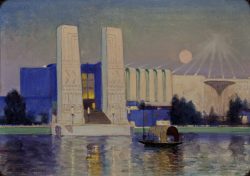Lover’s Leap, Galena, Missouri, Ozark Mountains
, circa 1920sOil on board, 18 by 20 inches
- Categories
- Immigrant artists
- Landscapes
- Zoom in on Artwork
- Print Page
- Email Page to Friend
The blue tints saturating Rudolph Ingerle’s romantic Lover’s Leap, Galena, Missouri, Ozark Mountains capture the misty light of a cool morning and set off the bright orange tints of autumnal foliage. The high horizon of the nearly square composition dramatizes the depth and breadth of the vista of river and mountains viewed from a lofty height. As interpreted by Ingerle, the Ozark Mountains region retains an Edenic purity but also bears the marks of settlement: framing the view at the far right is a decayed stone structure, perhaps the ruin of a dwelling, from which a sapling sprouts.
As a naturalized American who had received his art education in his adopted country, Ingerle believed that he was obligated not only to paint there but also to celebrate the best of America through his art. The regions he chose to paint—successively Indiana’s Brown County, the Missouri Ozarks, and the Great Smoky Mountains of North Carolina and Tennessee—reminded him of the remote mountainous countryside of his ancestral Moravia. Ingerle painted the Ozarks between 1913 and 1922 and, along with his friend Carl Krafft, helped draw the attention of other artists, particularly those of St. Louis, to the region’s wealth of subjects.
This painting’s title is inscribed, presumably by the artist, on the back of the board support. In Missouri some eight separate spots are known as “Lover’s Leap,” including one near Galena, in the southwestern corner of the state. The setting inspired at least one other canvas by Ingerle, Moonrise from Lovers’ Leap, Ozark Mountains, which was shown in the inaugural exhibition of the Society of Ozark Painters, held in Springfield, Missouri, in 1915. In this image, Ingerle almost certainly exaggerated the height of the bluff as well as the setting’s autumnal brilliance. By the mid-1920s if not earlier, the artist typically painted in the studio from notes and sketches made on site, “reconstruct[ing] nature in a fusion of his own imagination,” in the words of Chicago art critic Clarence J. Bulliet.i Writing at about the time Lover’s Leap, Galena, Missouri, Ozark Mountains was painted, the Chicago Post’s Lena McCauley noted that the landscapes of both Ingerle and Krafft “exhibit an imaginative quality, a distinct contrast to the realism that threatened to dominate a year or two ago.”ii
Wendy Greenhouse, PhD
Donated by M. Christine Schwartz to the Springfield Art Museum, Springfield, Missouri, in 2021
i C. J. Bulliet, “Artists of Chicago Past and Present. No. 23: Rudolph Ingerle,” Chicago Daily News, July 27, 1935.
ii Lena M. McCauley, “Art & Artists,” Chicago Post, Feb. 10, 1916.


